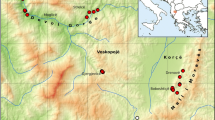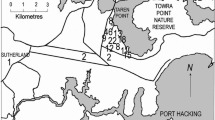Abstract
Experiences from the first efforts to translocate an orthopteran, the Mahoenui giant weta (Deinacrida sp.), are described. Some of the problems included monitoring at low densities, transferred weta dispersing and coordinating the different components of the translocation programme over a long period of time. Options for translocation are discussed, such as using wild-caught or captive-bred animals. Techniques of release, such as immediate release or using an enclosure on the release site, allowing transferees to breed, then releasing their progeny, are also discussed. It was concluded that the latter was probably the most effective approach to translocation.
Similar content being viewed by others
References
Anon (1986) Insect re-establishnient - a code of conservation practice. Antenna 10, 13–18.
Barrett, P. (1991) Keeping Wetas in Captivity. Wellington: Wellington Zoological Gardens.
Johns, P.M. (1997) The Gondwanaland weta: family Anostostomatidae (formerly in Stenopelmatidae, Henicidae or Mimnermidae): nomenclatural problems, world checklist, new genera and species. Orthop. Res. 6, 125–38.
Lovei, G., Stringer, I.A.N, Devine, C. and Cartellieri, M. (1997) Harmonic radar - a method using inexpensive tags to study invertebrate movement on land. NZ J Ecol. 21, 187–193.
McEwen M. (1987) Ecological Regions and Districts of New Zealand, 3rd edition. NZ Department of Conservation, Wellington, New Zealand.
Meads, M.J. (1994) Translocation of New Zealand's endangered insects as a tool for conservation. In Reintroduction Biology of Australian and New Zealand Fauna (M. Serena, ed.) pp. 53–6. Chipping Norton, Australia: Surrey Beatty & Sons.
Meads, M.J. and Notman, P. (1992) Resurvey for giant wetas (Deinacrida rugosa) released on Maud Island, Marlborough Sounds. NZ DSIR Land Resources Technical Record 90, 34.
Richards, A.M. (1973) A comparative study of the biology of the giant wetas Deinacrida heteracantha and D. fallai (Orthoptera: Henicidae) from New Zealand. J Zool. Lond. 169, 195–236.
Richards, G.E. (1994) Ecology and behaviour of the Mahoenui giant weta, Deinacrida nov.sp. Unpublished Msc thesis, Massey University, Palmerston North, New Zealand.
Sherley, G.H. (1994) Translocations of the Mahoenui giant weta Deinacrida n. sp. and Placostylus land snails in New Zealand: what have we learnt? In Reintroduction Biology of Austraiian and New Zealand Fauna (M. Serena, ed.) pp. 57–63. Chipping Norton, Australia: Surrey Beatty & Sons.
Sherley, G.H. (1998) Threatened Weta Recovery Plan. Wellington: Biodiversity Recovery Unit, Department of Conservation.
Sherley, G.H. and Hayes, L. (1993) The conservation of a giant weta (Deinacrida n. sp. Orthoptera: Stenopelmatidae) at Mahoenui, King Country: habitat use, and other aspects of its ecology. NZ Entomol. 16, 55–68.
Author information
Authors and Affiliations
Rights and permissions
About this article
Cite this article
Sherley, G.H. Translocating a threatened New Zealand giant orthopteran, Deinacrida sp. (Stenopelmatidae): some lessons. Journal of Insect Conservation 2, 195–199 (1998). https://doi.org/10.1023/A:1009664301311
Issue Date:
DOI: https://doi.org/10.1023/A:1009664301311




